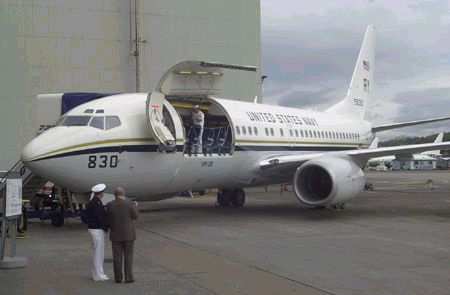|
Congress approved funding for the first four aircraft in 1997. A
contract for two C-40As was signed in August 1997, with an option for a
third. Delivery of the first aircraft was made in December 2000. On
July 30, 1999, Boeing Defense and Space Group was awarded a $43,700,000
modification to the previously awarded contract for the procurement of one
C-40A aircraft, to be delivered by August 2001. Five aircraft have been
ordered; a sixth aircraft was funded in the FY 2001 budget.
The C-40A is able to carry 121 passengers or 40,000 pounds of cargo,
compared with 90 passengers or 30,000 pounds for the C-9. In addition, the
maximum range for the Clipper is approximately 1,500 miles more than the
C-9. It has a fully digital "glass" cockpit that will allow for
future growth and is also fitted with a head-up display,
allowing pilots to keep their eyes up and outside in low-visibility
approaches. One major improvement is the C-40A's navigation system
includes GPS, which will aid in approaches to airports
in Third World countries with older, less reliable ground systems.

C-40A with SCD (Photo: Boeing)
The cargo area in the C-40A will be available in three variations: all
passenger with a capacity of 121, all cargo with a carrying capability of
eight pallets totalling 40,000 pounds, and a combination rig that will
allow for 70 passengers and three pallets. In this mode, the cargo
compartment is sealed to protect passengers and crews from the potential
danger of hazardous cargo.
The 737-700 is assembled from 375,000 parts, which could be a nightmare
for the Navy's supply system if required to purchase and order spares for
the fleet. But the Navy will be able to partner with private
industry-airline and cargo carriers-to purchase parts under a Contract
Logistics Supply system. A pool of parts will be created that all partners
can access quickly, and this will lower costs because we won't have to
stock millions of dollars of parts. The Navy will continue to do its own
maintenance.
The first Clipper has been certified by the Federal Aviation
Administration, much like civilian cargo and passenger aircraft. Because
this is a commercial off-the-shelf aircraft, and because the value for
potential resale is higher, it made sense to accept FAA certification.
The first C-40A was delivered in April 2001 to Fleet Logistics Support
Squadron (VR) 59, NAS JRB Fort Worth, Texas. Delivery of the first four
aircraft to VR-59 was completed by August 2001. The squadron
ceased operating C-9s on 1 October and began transition training. Although
limited operations will began shortly after delivery of the first
aircraft, VR-59 will not be fully operational until April 2002. The fifth
aircraft, scheduled for completion in June 2002, will go to VR-58, NAS
Jacksonville, Fla., along with one of VR-59's Clippers. VRs 59 and 58 will
operate three and two aircraft, respectively, until more are procured.
Eventually, each squadron will have four C-40As. At that time, a third
site will be selected to receive Clippers.
22 Nov 2004 - Boeing
Delivers Seventh C-40A Clipper to U.S. Naval Reserve
ST. LOUIS, Nov. 22, 2004 – Boeing on Saturday delivered the seventh
C-40A Clipper – a modified 737-700 "combi" airplane – to the U.S. Naval
Reserve.
Since 1997, the Navy has ordered eight C-40As to begin replacing its
aging fleet of 29 C-9B Skytrain aircraft used to transport cargo and
passengers around the world.
"Boeing and the U.S. Naval Reserve have a long history of working
together and we look forward to supporting the Navy's future airlift
needs," said Rich Reinheimer, Boeing C-40A program manager.
With its superior performance and range, 21st century avionics and
quiet, fuel-efficient engines, the C-40A will increase the Navy's
capability for rapid response to meet the fleet's airlift requirements.
A military version of the 737, the world's most popular jetliner, the
C-40A is certified to operate in an all-passenger configuration (121
passengers), an all-cargo variant or a "combi" configuration that will
accommodate up to three cargo pallets and 70 passengers on the main
deck.
The 737-700C convertible aircraft is manufactured by Boeing Commercial
Airplanes in Renton, Wash., before moving on to the company's Integrated
Defense Systems facility in Wichita, Kan., where an FAA-certified kit is
installed to provide the “combi” capability. The Naval Reserve provides
line maintenance on the aircraft following delivery.
The first Boeing C-40A was delivered to the Naval Reserve in April 2001;
the sixth in October 2002. The eighth aircraft will be delivered in
early 2005.
Three C-40 aircraft currently are based at Naval Air Station Carswell
Joint Reserve Base, Ft. Worth, Tex., and three at Naval Air Station
Jacksonville, Fla.
The C-40A program is part of Boeing Integrated Defense Systems, one of
the world's largest space and defense businesses. Headquartered in St.
Louis, Boeing Integrated Defense Systems is a $27 billion business. It
provides network-centric system solutions to its global military,
government, and commercial customers. It is a leading provider of
intelligence, surveillance and reconnaissance systems; the world's
largest military aircraft manufacturer; the world's largest satellite
manufacturer and a leading provider of space-based communications; the
primary systems integrator for U.S. missile defense and Department of
Homeland Security; NASA's largest contractor; and a global leader in
launch services. |  C-40 Clipper
C-40 Clipper



